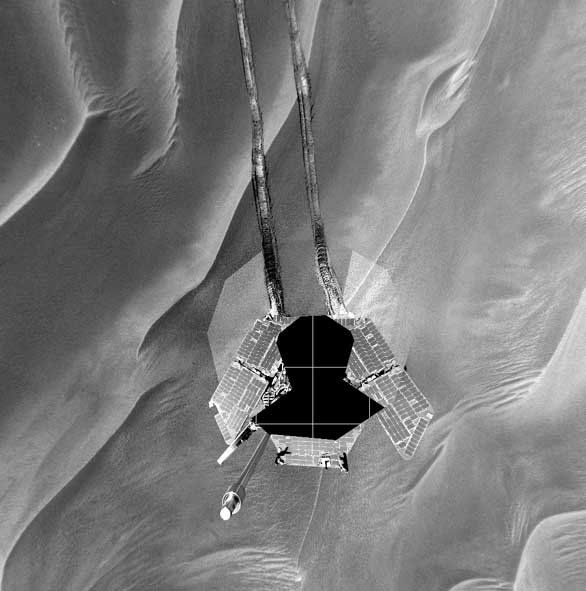[/caption]
If you watched the
"Five Years on Mars
" documentary on the National Geographic channel about the Mars Exploration Rovers, you probably saw how both rovers have gotten stuck in some of the small sand dunes on Mars surface. These dune fields on Mars are a bit of a mystery to planetary geologists, and in fact, there is nothing like them on Earth. The fields of rippled sand on Mars, called Transverse Aeolian Ridges (TARs), are found over large areas across Mars. The dunes themselves are smaller than the gigantic dunes also found on Mars, but the fields are bigger than any sand ripple fields found on Earth. TARs hold clues to past and present climate processes, and since they can be death traps for rovers, scientists want to know more about these unusual features.
TARS are formed by the wind. If you frequently peruse the
website for the HiRISE Camera
on the Mars Reconnaissance Orbiter, you'll see the word "aeolian" quite often in science themes and descriptions. Aeolian refers to any phenomena involving air movement. [caption id="attachment_20646" align="alignnone" width="500" caption="TARS in the northern lowlands on Mars, as seen by HiRISE. Credit: NASA/JPL/U of AZ"]
[/caption] The ridges assume many shapes, such as simple ripples, forked ripples, snake-like sinuous waves, barchan-like (crescent-shaped) forms or complex, overlapping networks.
In 2005, the Opportunity rover got stuck in a small dune, called Purgatory Dune for six weeks with its wheels firmly mired in what planetary geologists believe was a small TAR. After the rover was finally freed, from images the rover took of the surrounding area, mission scientists noticed they were surrounded by dunes. (See
this link
for movies of the rover wheels turning in the sand.) They had to carefully drive around all the dunes, which slowed the progress down considerably. So it's important to know where TARs are located to avoid landing among them on future rover missions.
One of the people studying TARs is Matt Balme, a research scientist with the the Planetary Science Institute. Balme and his colleagues have conducted a pole-to-pole planet survey of more than 10,000 images taken by the Mars Orbiter Camera, which was (is) on board the Mars Global Surveyor spacecraft.
Here's what they found about TARs:
-They are more common in the southern hemisphere than in the northern.
-They are found in an equatorial belt between 30 degrees north and 30 degrees south latitude.
-They exist in two distinct environments: near layered terrain or adjacent to Large Dark Dunes (LLDs). Those adjacent to dunes have formed recently, while those near layered terrain are millions of years old.
-They are abundant in the Meridiani Planum region and in southern-latitude craters.
The Opportunity rover's TAR encounter provided additional data, showing that at least that TAR was composed of an outer layer of granule-sized material ranging from about 2mm to 5 mm in diameter, Balme said. Beneath this was a mixed mass of fine and coarse particles. [caption id="attachment_20650" align="alignnone" width="580" caption="Opportunity looks back at Purgatory Dune after escape. See the other dunes in the surrounding area. Credit: NASA/JPL"]
[/caption] TARs need two things to form, Balme explained: a supply of sediment and strong winds. The sediment requirement helps explain why they're found near dunes and layered terrain and why they're confined to a central belt around the planet, Balme said.
"My theory is that the very young TARs are found near the Large Dark Dunes, which are also very young, because the sand blowing off the dunes provides the energy needed to form TARs," Balme said. "Meanwhile you have areas near layered landforms that used to have active sediment transport, but no longer. This shows a dynamic environment that has changed, and we might be able to use TARs as paleo markers to help decipher ancient climates."
Current Martian circulation models don't provide much evidence that wind patterns and atmospheric densities on Mars were significantly different in the past than from what they are today. "But I think the geology we are seeing suggests that there might have been different patterns and densities," Balme said. "The observations we're getting now from Mars Global Surveyor and the HiRISE camera are giving us really good data to drive the models."
Although Blame and his team have discovered much about TARs, they still don't know what materials compose the various TAR fields or why they're seeing these large features on Mars but not on Earth.
"Over the next couple of years we should be seeing many more images from HiRISE that can give us more information, for example, about the heights versus spacing and whether TARs have more in common with dunes or the ripple fields found on Earth," Balme said. "And they could provide insights into present and past climate patterns as we learn more about them and use that data to help drive general circulation models."
Source:
Planetary Science Institute
 Universe Today
Universe Today
